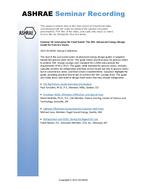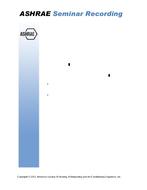Phase-change material (PCM) can be added to building envelope components, such as walls or roofs, to reduce peak diurnal cooling and heating loads transmitted through the envelope. This paper describes a simulation study to quantify the effectiveness of PCMs at reducing thermal loads through building envelope components and to develop a design strategy for the placement of PCMs within building components. The PCM studied is the paraffin octadecane, with an average melt/ freeze temperature of 25.6°C (78.1°F). Thermal loads through PCM concrete sandwich walls, frame walls, and steel roofs were simulated using an explicit finite-difference procedure with the indoor air temperature held constant and with two sets of outdoor boundary conditions: a single day in which the outdoor air temperature varied sinusoidally and a year of typical meteorological data from Dayton, Ohio. The simulation technique has been validated in previous experimental and simulation work.
Units: Dual
Citation: Symposium, ASHRAE Transactions, vol. 112, pt. 1
Product Details
- Published:
- 2006
- Number of Pages:
- 9
- File Size:
- 1 file , 3.8 MB
- Product Code(s):
- D-27921


